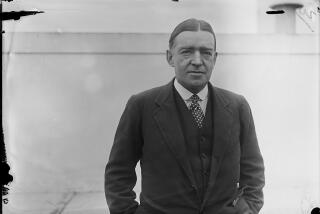Harold ‘Bud’ Froehlich, 84; designed the deep-sea vessel Alvin that found the Titanic
- Share via
Harold “Bud” Froehlich, the designer and chief engineer of the Alvin deep-sea research vessel, which located sunken bombs, underwater life forms and the Titanic, died May 19 at St. John’s Hospital in Maplewood, Minn. He was 84 and had multiple myeloma.
Froehlich was an aerospace and mechanical engineer at Minnesota-based General Mills Inc. when he was named Alvin project manager in the early 1960s.
General Mills, better known as maker of breakfast cereals and other foods, also made precision military equipment and high-altitude balloons.
The latter was Froehlich’s specialty, and his knowledge of creating small spheres able to endure hostile environments was crucial to his work on Alvin. He once told a reporter that “the same basic engineering principle is used to control both: ballast.”
Before Alvin, submersibles were limited because of their mechanics.
One such craft designed by Jacques Cousteau was viable only in shallow waters, and deep-diving bathyscaphs had restricted maneuverability because they were so heavy.
While at General Mills, Froehlich helped build a mechanical arm for the Navy-owned bathyscaph Trieste, which in 1960 descended 35,800 feet below the surface of the Pacific in the Mariana Trench.
Alvin took advantage of a new buoyant material called syntactic foam to attain broader movement underwater and reach reasonable depths. Froehlich and his collaborators combined syntactic foam with large, hollow aluminum spheres to build the vessel.
The result was a smaller vehicle better suited to the needs of the Navy’s Office of Naval Research and its scientific collaborators at Woods Hole Oceanographic Institution, a nonprofit research organization in Massachusetts that had an oversight role on Alvin.
By 1965, the vessel was able to take two passengers 6,000 feet underwater.
In later years, with a stronger titanium shell, Alvin could reach depths of more than 14,000 feet.
Froehlich told Minnesota Public Radio years later that winning the Alvin contract was an astonishing feat, because the Navy initially “was skeptical about a Wheaties company designing a submarine.”
Alvin, named for Woods Hole scientist Allyn Vine, could hold three people, including a driver. It measured 22 feet long and was 8 feet at its widest part.
According to “Water Baby,” an Alvin history, Froehlich chose the width “because it was the legal width limit of any object that could be transported on a highway without special permits or an escort.”
Froehlich moved on to other work in 1964, soon after Alvin was completed, but his basic design survived the decades as the vessel undertook a series of important missions.
In 1966, Alvin was used to find a hydrogen bomb after a U.S. military plane crashed off the coast of Spain.
In later decades, marine scientist Robert Ballard used Alvin to find giant tubeworms and other previously undiscovered aquatic life near intensely hot sea vents 7,000 feet down off the Galapagos Islands.
Ballard also guided a trek to the North Atlantic in 1986 to find the Titanic, which rested more than 12,000 feet under water.
Harold Edward Froehlich, whose father was a cabinetmaker, was born in Minneapolis on July 13, 1922.
After service in the Navy as a signalman during World War II, he graduated from the University of Washington with bachelor’s degrees in aeronautical and mechanical engineering. He earned a master’s degree in aeronautical engineering at the University of Illinois at Urbana-Champaign.
After early work in aeronautical engineering for Boeing and other companies, Froehlich began working on high-altitude balloons for the General Mills aeronautical research labs in the early 1950s.
In 1989, Froehlich, Vine and Navy official Charles Momsen received the Elmer A. Sperry Award for “the invention, development and deployment of the deep-diving submarine Alvin.” That same year, Froehlich retired from Minnesota-based 3M, where he designed surgical equipment, including skin staplers.
He is survived by his wife of 61 years, Avanelle Olson Froehlich of St. Anthony, Minn.; and two children, Steve Froehlich of Grasston, Minn., and Jane Hansen of Deerwood, Minn.






